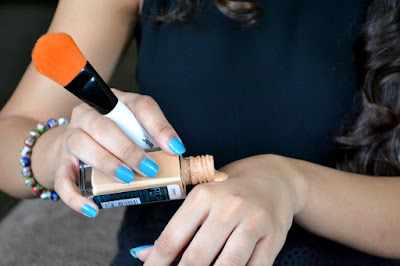Foundation is the most popular among the base make up products.That being said,we have realised a lot of people have misconceptions about foundations. They feel it makes them look “white” and unnatural. Add to that the hot humid weather of India, which makes people dread even the thought of having a layer of product all over their face. However with a simple understanding of foundations and the requirements of your skin, we can help you get rid of all your misconceptions.
What is foundation?
Foundation is a product that aims to provide an even toned coverage and make your skin look healthy. It may differ from high coverage to low coverage depending on the product and requirements of the skin. It is usually preceded by primer and colour corrector and is followed by concealer.
Types of Foundation:
Liquid foundation- The most common among all kinds as it suits all skin types. Liquid foundations may provide a matte or dewy finish.
Stick foundation- It is a bit rare and is mostly used by professionals. This is not the best option for beginners since it is a little hard to blend. It should be avoided by people having dry skin.
Powder foundations- Another common type of foundation. Mostly used to set the liquid foundation and prevent it from slipping and transferring. It is a good option for people with oily skin since it helps with oil control.
Cream foundation- Also known as mousse foundation is not a popular choice. It works best for normal to dry Skin.
How to pick the correct shade of foundation?
In order to identify the correct shade of foundation for yourself, you first need to identify your undertones. If you have a warm toned skin, then you predominately have yellow undertones. If you have a cool toned skin, then you predominately have pink undertones. It is highly unlikely for an individual to have only yellow or pink undertones. Most individuals are a combination of both. However whichever undertones dominates your skin is your primary undertone. Most Indians have yellow undertones. So while picking up your foundation, if the shade seems fine but it does not seem to match your complexion, you probably need to check for a product with different undertones.
Often while choosing a foundation, people swatch the foundation on their wrist. However there might be a slight difference in shade on your wrist and on your face. So, to get a more accurate match it is better to swatch the foundation on your jaw line.
Foundations also tend to oxidise which means they become a little darker a while after being applied. The oxidation depends on the product. Thus never pick up a foundation in a rush. Take your time. Swatch various shades. Look at other products and then come back and decide which shade works the best for you.
How to apply foundation?
Once the primer has settled into your pores, you can begin with the application of the foundation. The application depends on the texture of the foundation and the coverage you are looking for. If you are not looking for full coverage, just take a small amount of foundation on the back of your palm, dot it all over your face and neck with your fingers and blend it with a buffer brush or make up sponge. However if you are looking for higher coverage, use a foundation brush instead of your fingers. This is the general method of application for liquid and cream foundations.
The application for powder foundations is comparatively simpler. All you need to do is dab a powder brush into the product (You can remove the excess product) and then just simply swirl the brush all over your face in downward strokes.
To avoid a patchy look remember to put some foundation on your neck as well.
Alternatives for Foundation:
BB Cream( Blemish Balm or Beauty Balm) - It is a tinted moisturiser with anti aging properties providing a limited coverage. It can be used as a primer, to conceal blemishes and to brighten one’s skin. This is definitely a better option during those breakout days, giving you a glow without applying too much.
CC cream (colour correcting or complexion correcting cream)- It is similar to a BB cream but differs in coverage and texture. It has a higher coverage with a thicker texture compared to a BB cream.
We hope you found this post helpful. Let us know if you have any feedback or questions.We will be back with a new post next week.
Photography Credits: Shivam Bhatt.



No comments:
Post a Comment